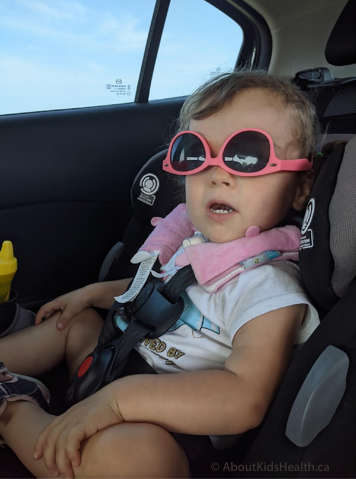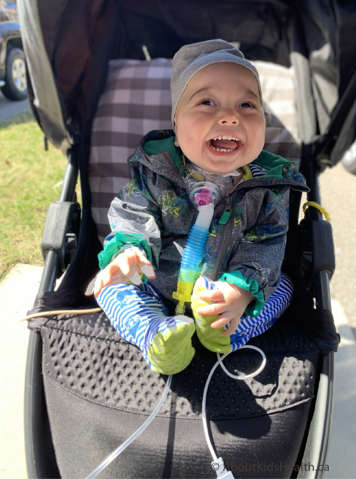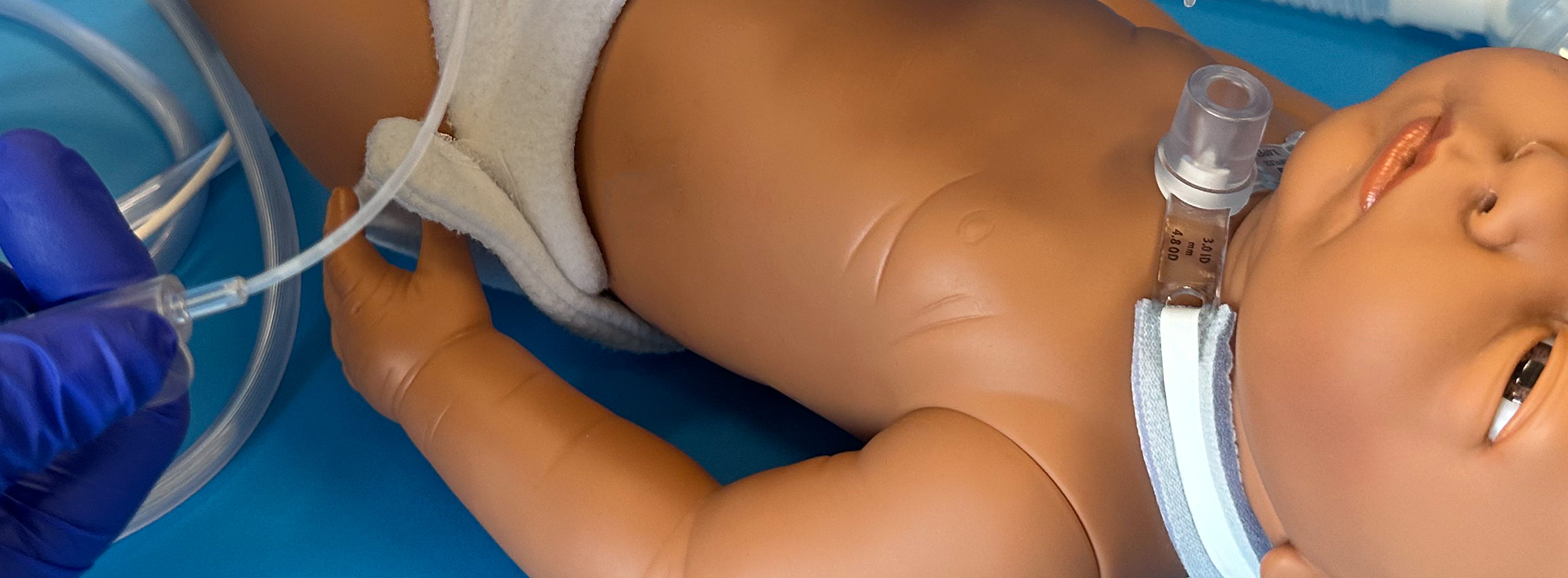At the end of this chapter, you will be able to review:
- equipment and supplies needed to leave home (i.e., appointments, school, parties)
- how to prepare to go on a vacation
Equipment to bring with you

- oxygen, if needed
- Always bring more oxygen than you think you will need. You may be out longer than expected, for instance if you are delayed in traffic.
- If you are bringing an oxygen tank in warm weather, please note that oxygen will evaporate faster, using up oxygen more quickly than when at home. A portable oxygen concentrator is recommended instead. Please speak with your respiratory vendor for more information and costs.
- oximeter, if your child’s health-care team has recommended one with extra probes and charging cable
- emergency tracheostomy kit
- manual resuscitation bag with tracheostomy adaptor, mask and/or stoma mask if your child has been prescribed one
- feeding supplies
- suctioning equipment and supplies (Suctioning. chapter)
- travel ventilator (if your child is on a ventilator)
- power cords to recharge batteries if needed
- back-up batteries
- CoughAssist machine with circuit (filter, tubing and tracheostomy adaptor), if your child uses one
- medications
- emergency contact list
- child’s care plan – in case your child requires medical attention
Travelling when your child uses home oxygen therapy

Your child will need to make some trips outside the home while using home oxygen therapy. It is a good idea to think about, and plan around, potential obstacles to make travel easier for you and your child.
Transporting your child’s oxygen equipment safely
- If your child is using a stroller, make sure it is large enough to carry your child, travel bag and oxygen therapy system. Be careful about placing a heavy tank on the back of a stroller; the weight of the tank may cause the stroller to tip backwards.
- You can store extra oxygen in your car. To minimize the risk of fire, carry cylinders (tanks) lying down supported by cushions or pillows. Never store oxygen in the trunk of the car.
- Make sure oxygen is not stored in a hot car or outside on a hot day (e.g., at the beach).
- The vehicle's air temperature should remain under 51 degrees Celsius (124 degrees Fahrenheit).
- Do not smoke or vape near your oxygen tanks or allow others to.
- Avoid campfires, candles and other sources of open flames.
- Do not cover oxygen cylinders with any blankets, clothes or rags.
- As a caregiver of a child needing home oxygen therapy, you are eligible to use parking spaces reserved for vehicles used to transport people with a disability. Ask your health-care team to fill in an accessible parking permit form for you.
- Ensure you carry the oxygen key in case you need to change the regulator to a new tank while you are out!
- Have the phone number of your oxygen vendor available at all times.
- If you are using a portable oxygen concentrator, ensure you carry the AC plug and extra batteries.
- If travelling by airplane contact your child’s health-care team and oxygen vendor well in advance of travel. There are forms that need to be completed and the oxygen vendor will need to source an oxygen device that is compatible for the plane and your child’s oxygen needs.
Travelling locally

When travelling, take extra time to research and plan your trip to make sure it is safe and enjoyable. Make sure you have enough supplies and take all the equipment needed for your child’s care outside the home.
Travelling to and from medical appointments
When you make an appointment at the hospital for your child, tell the clinic staff your child is using home oxygen therapy. Tell them again when you arrive. You can use their supply of oxygen while you wait and while your child is seen in the clinic. Not all areas have wall oxygen. Ask the medical team for help if you are unsure. Please also ensure you are using the oxygen wall unit and not the one labelled ‘air’.
Please note that if you run out of oxygen on the portable unit during your clinic visit, you must call your respiratory vendor to get more oxygen so that you can get home safely with your child after your appointment.
Going on vacation
Before going on vacation, co-ordinate supplies and delivery with your medical vendor. For instance, you may need to arrange a short-term portable oxygen concentrator rental if you do not have one already. If you are staying within Canada, companies often have branches in other provinces and can arrange oxygen delivery at your destination. Check with your vendor for out of the country options. Only limited oxygen delivery sources are permitted on airplanes.
Plan any trips at least two to three months in advance.
Long-distance travel
Discuss your trip with your child’s health-care provider and the rest of your child’s health-care team to prepare emergency plans in case of illness. Your child’s team can prepare any letters or other paperwork you might need and order the essential equipment for your child.
In addition to the equipment outlined above, you will also need to bring the following supplies and documents when travelling long distances:
- surge protector, adapters and converters for the area you are travelling to
- oxygen system compatible with airplane
- letters and other paperwork
- medical forms from the airline(s)
- medical letter to let you bring equipment on aircraft
Who do I need to contact before my child travels?
You will need to contact:
- your child's health-care team
- your medical vendor (home supplies company)
- your airline, if applicable
Contacting and visiting your child's health-care team
- When planning to travel, inform your child’s health-care team so that they may assist with airline medical forms and certificate.
- Ask your health-care provider for a letter and bring this with you onto the plane if travelling by air. The letter should include the health-care provider's name and contact information, your child's medical diagnosis and the reason your child is using the tracheostomy, oxygen and/or ventilator.
- Once you have bought your airline tickets, and ideally at least four to six weeks before your flight, send your child's health-care team the medical forms for the airline you will be travelling with.
Contacting your vendor or home supplies company
- Contact your vendor at least two to three months before you travel to arrange any equipment you may need to rent and/or buy (such as portable oxygen units, respiratory equipment, batteries and so on) at your final destination.
- The vendor can help you contact the vendor at the destination for your child's equipment.
- The vendor can also give you estimates of equipment costs so you will be more prepared.
Travelling by plane
- If you are flying, inform your health-care team so that they can help you complete any airline medical forms. Contact the airline for the specific costs and requirements related to bringing a portable oxygen concentrator with you and/or using on-board oxygen.
- Give yourself extra time to go through security in case your equipment needs to be inspected and have enough power to withstand any potential delays.
Contacting the airline
- Book flights as far in advance as possible and tell the airline about your child’s medical needs before or at the time of booking. Some airlines have restrictions on the number of passengers with specific medical needs.
- Ask the airline as early as possible about their procedures or equipment so that you have enough time to make special arrangements or buy any special equipment that you need before the flight.
- Medical supplies and equipment: Remember that you can carry medical supplies and equipment onto the plane in addition to standard carry-on baggage.
- Travel form: You and your child's health-care team will need to fill in a travel form and fax or email it to the medical assistance section of the airline. You can find the medical forms online. Some airlines may need a medical certificate several weeks before discharge.
- Medical letters: Different airlines have different requirements for medical letters. Remember to ask the airline what information needs to be included in this letter.
Travelling by bus or train
- Bus and train lines vary in their own rules and regulations.
- Most bus lines will allow passengers to carry portable oxygen, but you’ll need to check with them in advance of your trip.
- Some train lines may permit you to bring oxygen on board, but you may be required to use your own generator for power. Always call the bus or train line you’re planning to use far in advance of your trip, so you can plan accordingly.
- Try to book a seat near accessible power outlets, if available.
Travelling on a cruise line
- Ask your oxygen supply company (vendor) to calculate how much backup oxygen you’ll need to bring.
- Do not place your oxygen equipment in checked baggage. It could become lost or damaged and is often not permitted.
- Arrive early in case your equipment requires inspection prior to boarding.
Travelling in a car
- Never store your oxygen tanks in the trunk of your car where they may combust in the event of a rear-end collision.
- Store oxygen tanks or liquid oxygen securely in the back seat or upright on the floor.
- Check all connections are tight so that there are no leaks.
- Pack backup oxygen as needed.
- Ensure tanks are in their carrying cases and kept out of direct sunlight or other sources of heat.
- Keep a window open slightly to have a source of fresh air cycling through your vehicle to prevent oxygen from building up in the car.
- Look up respiratory vendors along your route in the event you require more oxygen or other supplies.
Additional tips for preparing for a trip with your child
- Organize appropriate travel medical insurance.
- Discuss your accommodation needs with your hotel or travel agent.
- Divide your child’s medications and medical supplies between your carry-on baggage and checked baggage. Keep supplies in their original, labelled containers.
- Bring copies of your child’s prescriptions with you.
- Before travelling, visit the Government of Canada travel and tourism website for travel safety tips.
- Obtain the contact number for a medical supply vendor at your destination in case you need any equipment for your child while you are away from home.
- Ask your primary care provider if travel vaccinations are required.
